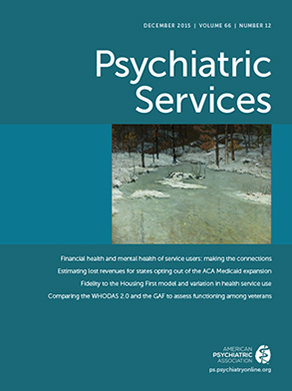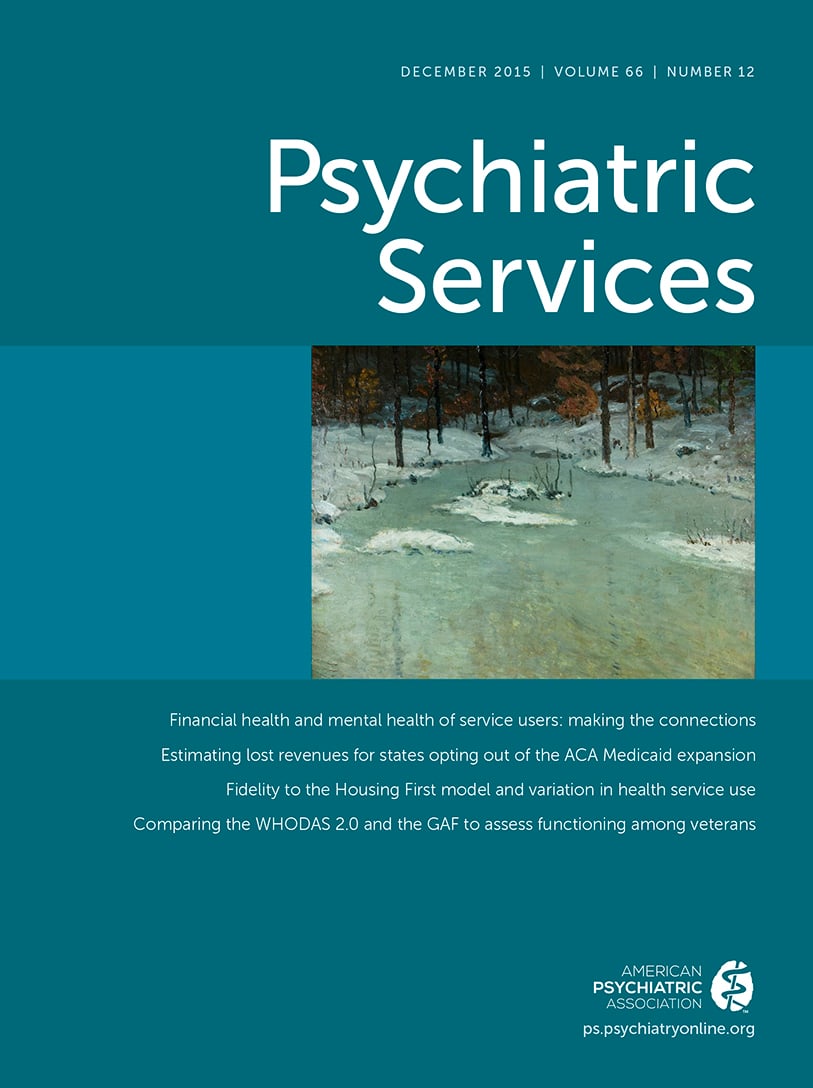The U.S. federal government provides two large disability programs for people with severe mental disorders. Social Security Disability Insurance (SSDI) is an insurance program for people who have worked substantially during the ten years prior to becoming disabled. SSDI beneficiaries receive a monthly stipend and usually receive Medicare insurance two years after qualifying for SSDI. By contrast, Supplemental Security Income (SSI) is an income program for people who have a disability and are impoverished. SSI beneficiaries receive a smaller monthly stipend and usually receive Medicaid insurance when they qualify for SSI. Because serious mental illnesses typically begin early in life, before people have built a substantial work history, most people with psychiatric disabilities who receive care in community mental health centers are SSI beneficiaries and thus are the predominant group in most studies of employment and barriers to employment.
In the recent Mental Health Treatment Study, 2,055 SSDI beneficiaries in 23 U.S. sites participated in a randomized controlled trial in which the treatment group received a comprehensive package of evidence-based supported employment, systematic medication management, other mental health services, full insurance coverage, and freedom from continuing disability reviews (
1). The treatment group attained better employment, mental health, and quality-of-life outcomes over two years, but a substantial minority of the treatment group beneficiaries achieved minimal or no paid employment in two years (
2).
With this study, we aimed to understand barriers to employment among the SSDI beneficiaries in the Mental Health Treatment Study who did not achieve successful employment.
Methods
Research assistants tracked vocational outcomes among all study participants (N=2,055) via quarterly interviews for two years. Because a small number of participants worked very briefly, we defined as nonworkers the 430 (43%) treatment group participants who worked for less than one month or not at all, according to nurse care coordinator case file records.
From the literature on employment barriers (
3–
10), we identified 14 common barriers. Near the end of the study in 2010, the multidisciplinary clinical teams (nurse care coordinator, supported employment specialist, and other mental health providers) at the 23 study sites assessed each nonworker’s barriers to employment, identifying up to three factors as primary, secondary, or tertiary barriers. The teams discussed each nonworking participant and made assessments by consensus.
Results
We had demographic data for 429 of the 430 nonworkers. Of 429 nonworkers, 55% (N=236 ) were female and 45% (N=193 ) were male; 16% (N=67) were under age 40, and 84% (N=362) were older. The group’s racial-ethnic composition was 62% (N=266) Caucasian, 29% (N=125) black or African American, and 9% (N=38) other, plus 8% (N=32) of Hispanic background. Marital status included 49% (N=211) never married, 26% (N=110) divorced, 18% (N=78) married, and 7% (N=30) with another marital status (separated, widowed, or living as married). For education, 13% (N=56) had less than a high school education, 24% (N=101) completed high school only, 36% (N=156) had some college or technical school education, and 27% (N=115) had an associate's or higher degree. Diagnoses for the 410 nonworkers with research diagnoses included 32% (N=133) with major depression, 30% (N=123) with bipolar disorder, 40% (N=162) with schizophrenia and related disorders, and 18% (N=72) with other diagnoses, plus 44% (N=180) with a lifetime co-occurring substance use disorder. Some of the nonworkers had multiple diagnoses. These characteristics were similar in the overall Mental Health Treatment Study group (
2).
Table 1 summarizes the assessments of barriers to employment. Three factors dominated. For 76% (N=325) of the group, poorly controlled symptoms of mental illness, nonengagement in supported employment services (defined as meeting with an employment specialist fewer than four times), or poorly controlled general medical symptoms were the primary barrier to employment. No other factor was primary for even 10% of the participants. The same three factors predominated among the secondary and tertiary barriers.
Discussion
Among SSDI beneficiaries with psychiatric impairments who expressed interest in employment and received evidence-based services, a substantial minority participated for two years but did not achieve paid employment for at least a month. Clinical teams assessed three factors as strong barriers to employment: uncontrolled symptoms of mental illness, nonengagement with supported employment services, and uncontrolled symptoms of general medical issues.
The literature widely documents symptoms of mental illness as a barrier to employment (
9,
10). Despite receiving systematic medication management support, some participants did not respond to treatment. Positive or negative psychotic symptoms, mood symptoms, cognitive deficits, or social deficits might have interfered with job performance, and the assessment form did not differentiate among types of symptoms. Some beneficiaries entered the study but did not engage with the employment specialist or discontinued meetings without looking for a job. Without additional data, we cannot speculate as to why they did so. Many participants had serious general medical problems (
1). General medical comorbidities are prevalent among people with psychiatric disorders (
11) and may affect employment (
12).
In addition to the three major barriers, the barriers concerning family problems, poorly controlled substance use disorders, disengagement from supported employment services (defined as dropping out after at least four meetings with an employment specialist), and behavior problems affected smaller proportions of the nonworkers. The relative unimportance of these factors contradict the literature on barriers to employment, for several possible reasons: the literature largely derives from community mental health center clients who tend to be SSI beneficiaries rather than SSDI beneficiaries (
13), the clinical teams have different perspectives compared with clients or researchers, and the restriction to choosing the top three factors may have excluded some important but less common factors.
This analysis was limited in several respects. First, the findings may generalize only to SSDI beneficiaries with serious mental illness who desire competitive employment, which represents a small proportion of SSDI beneficiaries (
1). The results do not apply to SSI beneficiaries, who tend to be younger and have a greater interest in employment (
8). Second, the identified barriers represent only the clinical teams’ perspectives; participants’ and researchers’ perspectives may have identified different factors. Third, we did not check the clinicians’ assessments for reliability. Fourth, we do not have similar assessments on the successful workers, who may have encountered many of the same barriers. Subsequent analyses of data from the Mental Health Treatment Study will consider the workers as well as the nonworkers, including data on participants, study sites, treatments, implementation fidelity, local unemployment rates, and other factors.
Conclusions
This analysis used clinicians’ assessments of the major barriers that affected SSDI beneficiaries with psychiatric disorders who expressed interest in employment but were not successful. Three factors emerged: uncontrolled mental illness, nonengagement in supported employment services, and uncontrolled general medical problems. Future efforts to help SSDI beneficiaries return to work should address these prominent barriers.
Acknowledgments
This report extends work conducted under contract SS00-05-60072 between the U.S. Social Security Administration and Westat. This analysis was conducted for the benefit of the Social Security Administration. The views expressed herein are those of the authors and not necessarily those of the Social Security Administration.

